What you might not be aware of is that the tin can itself can be extremely useful , where the material is sturdy, the edges are sharp, and the shape of the can is perfect for tunnelling or digging.
To ensure you can make the most of the resources at your disposal, here are 13 ingenious uses for a tin can in a survival situation.
Tin cans can be extremely sharp when cutting, and while a small wound may not be that big of a problem in organised society, it can be a real pain after the SHTF. Cover up with gloves to prevent any issues.
1. Secret Storage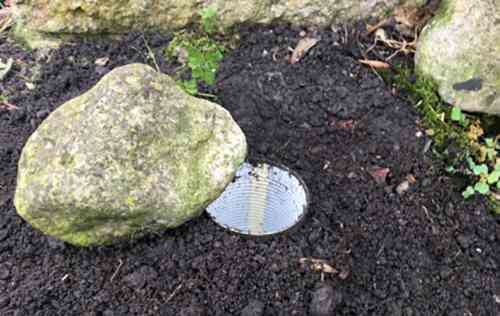
A tin can presents an excellent vessel for storing small items such as keys or cash in secret. You can scoop a chunk of dirt out of the ground using the can, before planting the can in the earth and hiding items inside. Retain the can lid or use a piece of plastic to cover the top, and then hide the can with a layer of soil or even a strategically placed rock. You now have a secret underground storage container that only you now the location of — just don’t forget it!
Related: How to Conceal Weapons in Your Vehicle
2. A Scoop Shovel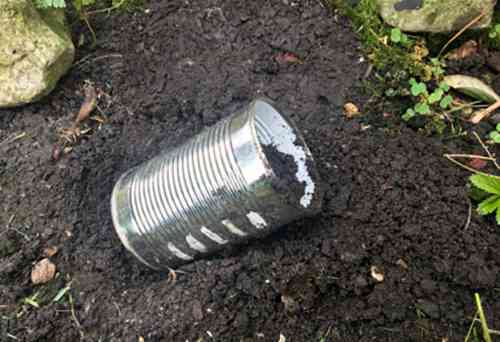
As alluded to in the previous use, a tin can make an excellent scoop shovel. Simply remove the lid and use the empty can to lift out chunks of earth, sand, or whatever other material you’re looking to transport or excavate. It’s not a particularly quick digging tool but it’s small and easy to carry, which is less than can be said for a shovel or spade.
3. A Cooking Pot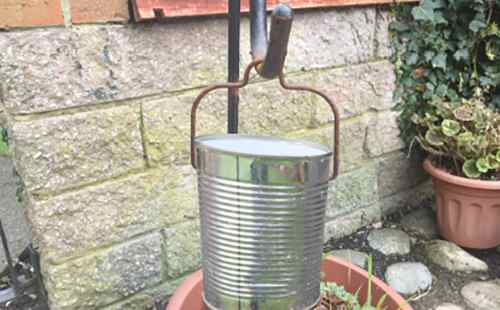
A tin can is also a ready-made cooking pot that would be great for boiling water; this can prove essential for making food, brewing coffee, and sterilizing medical apparatus. Simply hang the empty tin can over a fire using a wire handle and watch as the contents are heated thoroughly.
Related: The Lost Art of Scratch Cooking
4. A Cooking Stove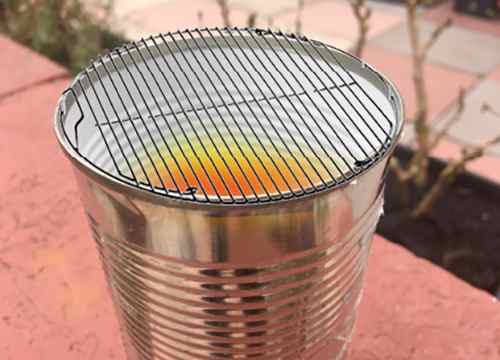
While using the same chemistry, this is different to using your can as a cooking pot. Constructing a mini stove involves filling the can halfway with sand, before dousing the material in a flammable liquid (alcohol is best as it emits low-toxicity fumes). Cook your food on a skillet or grate on top of the can, flipping and rotating it to be sure it cooks thoroughly.
Related: How To Build an Earthen Oven; DIY Easy Tutorial With Pictures
5. A Candle Holder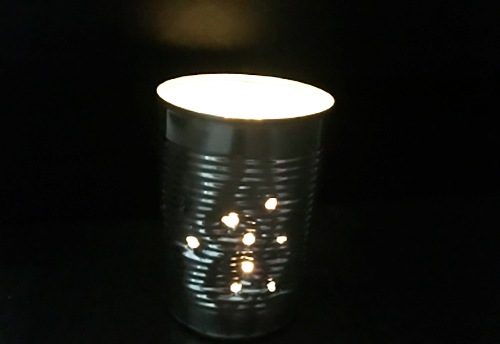
When SHTF and the electric goes down, you’ll more than likely be relying on candles for a light source and even heat. Use a tin can to hold a candle, protecting it from wind and moisture. By puncturing the sides of the can, you can also create some atmospheric firefly lighting for your abode.
Related: How To Make 30 Hours Survival Candles with Soy Wax
6. A Plant Pot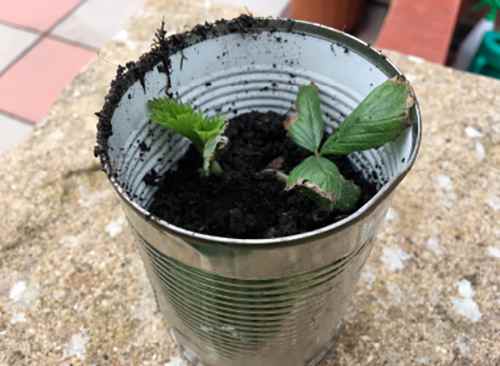
While in an ideal world you will have a comprehensive garden full of nutritious vegetables, some plants need to start off in a small pot before being transported to the garden. Puncture a few small holes in the bottom of the can to allow drainage, before filling it about halfway with soil. You can now plant your seed and water the plant as and when. When your plant is big enough to be transported, you can remove the bottom of the can so the plant simply slides out, soil intact.
7. A Shower-head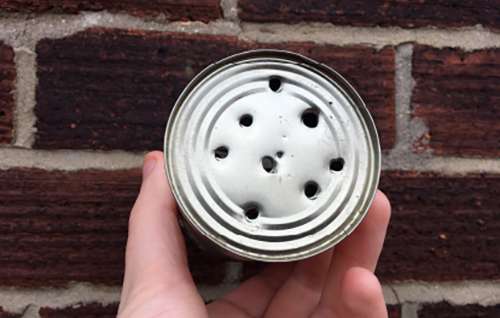
If you’re ever in a situation where your only source of water is a hose and spigot, you can make a relatively effective shower-head out of a tin can. Simply puncture a series of holes in the bottom of the can and secure the hose to the top with duct tape or a sheet of plastic — anything to ensure it is watertight. The water will spray out in the same way that it does a shower-head. While you may not wish to use this can as a shower-head again, given then rust, you can reuse it as a plant pot.
8. A Shiv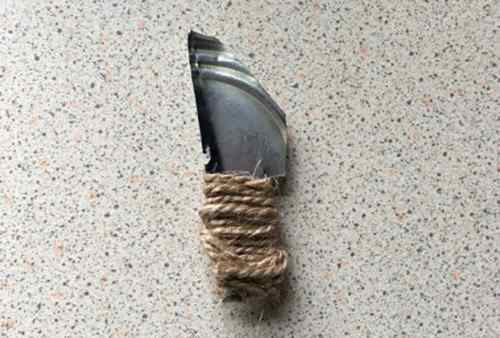
In a survival situation, you’re going to want to carry a sharp, lethal weapon with you at all times. You can use a regular tin can to fashion a very effective shiv. Simply cut out an arrow shape from the tin can, making sure that the point is sharp and pronounced enough to use as a weapon. Wrap the arrow length with tape or string, so you can grip it tightly without injuring yourself. You may want to carry this in a pouch or cloth to prevent accidentally injuring yourself.
9. A Fishing Lure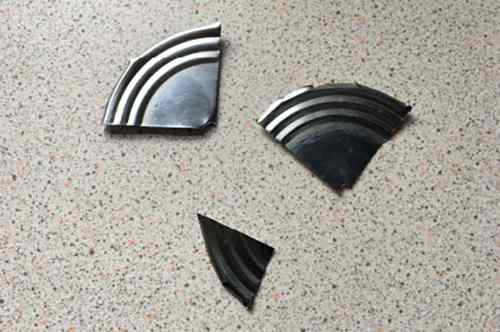
Hunting food is essential in a post-apocalyptic environment, and it’s likely there will be a surplus of fish due to disruption of global trade. While you can cut a fishing lure from the can using sturdy scissors, it’s easier to fashion one from the lid of the can by folding it until it breaks in half, then doing the same with the two halves until you have 4 individual shiny fishing lures. The sharp edges will be great for baiting, while the shiny surface will capture the attention of fish swimming nearby.
Related: Six Primitive Traps For Catching Game In The Woods
10. An Alarm System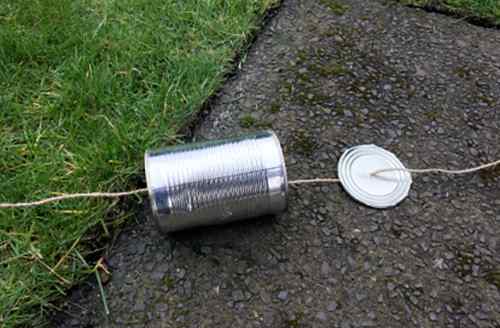
One of the major qualities of a tin can is the rattle it makes when disturbed. You can take advantage of this by creating a ‘hobo alarm’. By surrounding the perimeter of your settlement with string attached to tin cans with a stone or two inside them, you will be notified if anyone attempts to pay you a visit by the jangling and rattling of your DIY alarm system.
Related: 3 Non Lethal Booby Traps From An Army Vet
11. A Water Filter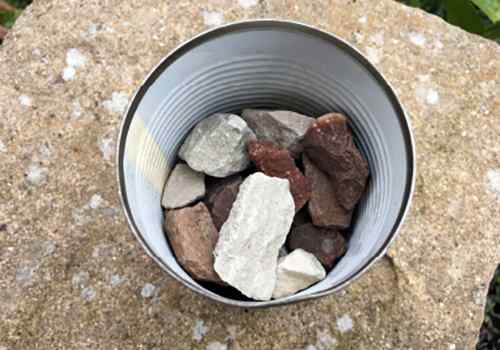
If you find yourself in a situation where water is in short supply, you may be forced to drink from natural water sources where the liquid isn’t as clean or smooth as you would necessarily like. To make a water filter, puncture a few holes in the bottom of the can and then half-fill the container with layers of gravel, sand and pebbles. The water will pass through, leaving rogue debris behind, allowing you to collect the liquid ready for boiling.
12. A Signalling Device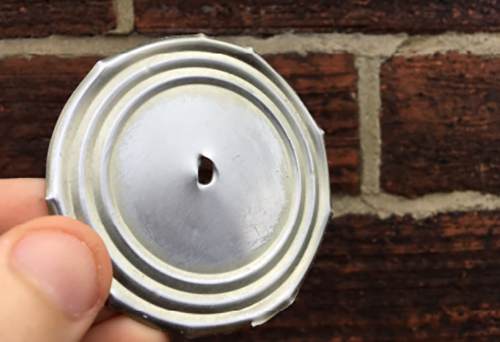
The shiny qualities of a tin lid can make for a great emergency signalling device. Puncture a hole in the center of the lid, before shining and buffing one side of the lid — the idea is to make it as shiny as possible so it reflects light easily. You can then peep through the hole and aim the lid in the direction of the person you’re looking to signal. The light reflection will capture their attention and alert them of your presence.
And finally…
13. Tin Can Alley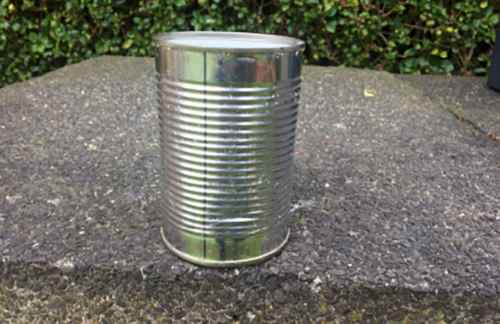
Did you ever play ‘Tin Can Alley’ as a child? The classic game involved shooting plastic cans from a wall using an electronic rifle. In a post-apocalyptic world however, you’ll need to become proficient and accurate with a real rifle, and shooting tin cans off a wall is actually a great way to practice your marksmanship. You never know when you might need to use your rifle, so be sure that you’re well prepared.
Whoever thought that a regular tin can could be so diverse? What do you do with your tin cans after you eat the content?
You may also like:
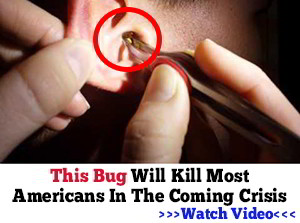 8 Tips To NEVER Get Your Car Stolen (from An Ex-Thief; Guest Post)
8 Tips To NEVER Get Your Car Stolen (from An Ex-Thief; Guest Post)
You Will Not Survive An EMP Strike Without This (Video)
Emergency Bag to Keep in Your Car in Case of an EMP
Debunking Expiration Dates – What You Need to Know

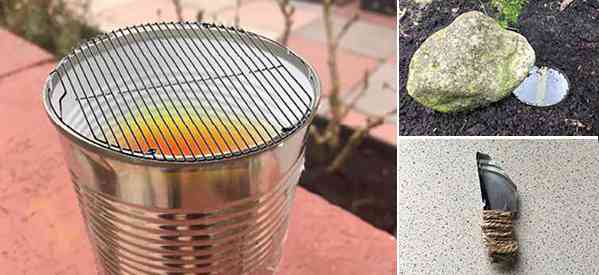




















When using the can for cooking I have found that using newspaper is great when you are cooking meat since the fat grease fuels the fire while cooking and it also does not create a lot of smoke. Just wad up 3-6 sheets of newspaper into as small a ball as possible, lite it and start cooking the meat, the paper absorbs the fat grease which makes the fire last a longer time than you think it would. I used to cook hamburgers on the jobsite for me and my crew of six and never had any trouble with this method.
Are you worried about the burning ink in the food? I guess there is something I don’t know about that, and I could be wrong, if I am please let me know.
Think about how often you are reading a book or magazine and you moisten your finger by licking it to turn pages. In England it is traditional to wrap fish and chips in newspaper. How often have you read a newspaper or magazine and then gone to eat without washing your hands? Your exposure to ink and accidental ingestion over your lifetime has been substantial. Cancer in the printing industry was caused by using benzene to clean the type when hot metal type was used and to clean the press at the end of the day. It wasn’t the ink that caused the cancer, it was the benzene and when the use of benzene ceased, so did the incidence of cancer. We have been exposed to printer’s ink since the invention of the printing press and more generally since the invention of the automatic paper making machine. I think a fear of exposure to some carcinogen in ink from burning is very minimal. You exposure is more from tars in the smoke that come from incomplete combustion. Arterial clogging from the fat in the meat will probably kill you first. In an EOTW situation there are so many things that you will be liable to die from that are far more likely like diarrhea, typhoid, infection, flu, tuberculosis, vitamin deficiency, all the things that used to kill folks in the 17th century that we no longer even think about. We think the number of folks who die of lung cancer is terrible. It is nothing compared to the number of folks who died of TB prior to the invention of penicillin. The American Lung Association started life as the Tuberculosis Society in order to try to combat the prevalence of tuberculosis. When I was young it was called the TB Society. It only changed its name when lung cancer overtook TB as a cause of death.
I lived in the UK for two years, serving our country, and they banned the use of newspaper wrapping up fish and chips in the 80’s, because there was a direct link to certain illnesses at the time, mainly based on the lead levels in ink. They now use a parchment type paper with news print on it. That was why I asked the question in the first place, because I knew nothing about the whole ink issue. Thank for the update!
JT: Your post is confusing. If the problem was with the ink, using ink on a parchment type paper is not going to solve the problem. I think the whole thing was a chance for some MP to do an early Bloomberg “protect the peasants from themselves” move. Think about it a minute. The problem is caused by ink on newsprint so we will substitute hard surfaced paper with ink on it for newsprint. What has changed if ink is the carcinogen? The printing substrate won’t have a difference on the printing ink on the surface. But thinking is not something politicians do regularly. It certainly is not something the electorate do very often either when in the polling booth, otherwise we would not have the deadwood we have in Sacramento, Washington, District of Corruption, London, Paris or any other place where politicians gather — except unless there is a pile of cash laying about, then the folks who are buying the politicians usually have a modicum of brain installed.
In 1973, the ink in printing was changed to vegetable base vs. petroleum base, so there is no toxicity when using newspaper.
Also, a quarter sheet of newspaper, rolled around in your hand to soften it, makes excellent toilet paper (I was raised when Granny had on outhouse with newspaper on the seat beside the hole).
most ‘newsprint INK’ is soy based. so unless the newspaper is contaminated it is OK to use.
Well, not to get into a diatribe about the base of ink on a survival, but soy oil is merely the carrier. When I think of carcinogens in printing ink, I am thinking more of the pigment that colors the ink. Black ink is lamp black which is made from soot. I don’t know the base of the dye for the other colors. Soot does contain carcinogens. However, I feel that the contamination one might get from casual contact with ink on a printed page or the amount contained in smoke from burning newsprint is akin to getting lead poisoning from the lead seals that used to be on wine bottles. My take on that was that if you were getting lead poisoning from the residual lead on the lip of a wine bottle that is washed off into your wine glass, your problem isn’t lead poisoning, you are drinking way, way too much wine. If you are working in an ink manufacturing plant, if you are the second assistant on a big 36″ 5-color press and your job is to do the wash-up, then the possible carcinogenic make up of the chemicals involved might be of concern. In the 25 years I owned a printing company I never heard PIA (printing assoc.) make any mention of the possibility of cancer from inks. By the way, there are hard dry inks that still contain petroleum distillates. VanSon Tuff Tex is one. It is especially good at drying hard any place you don’t want it, ink knife, press rollers, the drop of ink on your new shoes, your fingernails. Now to add survival information to make this post relevant: My favorite fire starter is to cut newspaper into one inch wide strips the length of the newspaper page, roll them up tight, put a rubber band around the roll, soak it in water, let the roll dry, remove the rubber band, soak the roll which will not come open easily now that it has been soaked in water and dried, in olive oil (use the cheapest you can find, no yuppie extra virgin reserve for this exercise) Let the roll drain. Now when you want to start a fire, take about a foot length of the oil soaked newsprint and light one end. You will have a fire starter that won’t go out easily and will burn sufficiently long enough to start even wet wood. A quart of olive oil will make enough of those to last you a lifetime. I make the rolls so that they are about 3/4 to 1 inch in diameter and, of course, 1 inch wide. They fit well in a small olive or pickled onion, caper or other small jar of sufficient diameter. A single match will get them blazing.
Good information…. thx for sharing!
I soak paper towels, “select a size bounty”, in the left over bacon grease, roll them up, pack them in snack bags, and freeze them. They last for ever, as long as you have electric of course. One roll burns super slow and smells like bacon.
Hey Chuck, I’m an old printer myself, I ran a Multilith 1250 with a T-51 head added on.
Keep prepping bro!
Back in the mid 60s I was a 4 color Process Camera operator; until a computer scanner took my job!!!
Canola oil, bacon grease, tallow, wax. It doesn’t have to be specifically olive oil, FYI.
Tin cans set on a brick and with a candle inside make a neat little Franklin stove to heat a small area. Could be a life saver in your car or truck.
If used in a closed space like a car be sure to allow for fresh air to enter the space as the CO2 content can put you to sleep, permanently. Better to carry heat packs in your to go bag.
Favorite method of suicide in Japan these days, a charcoal brazier inside a car, in an enclosed room or even under a blue plastic tarp out in the woods.
Its CO, carbon MOnoxide that kills. It is formed when combustion gasses are recycled. CO2 is carbon Di oxide. It’s what fizzes your soda.
Your message..
CO
C02 is not good, but C0 is worse. Carbon monoxide replaces the oxygen in your red blood cells and you sufficate.
Oh, what fun is this article! So ingenious, so simple! Thanks for this!
I do have a non-related question. Where do you have dirt that looks that rich and friable? Wow! It looks like rich bottomland. Is it? Or just the result of 7 years of compost enrichment?
Some of the uses raise the issue of other tools and supplies that would be useful or even necessary to produce the desired result. Tin snips to cut the can, duct tape, twine, an awl, wax, scissors, — How about an article focusing on a minimal list of essential tools?
In an EOTW situation, cans can be used as caltrops. If you have no other use for the can, cut the can in half using a hacksaw blade so that you cut on the pull stroke rather than the push stroke. Take tin snips and cut spikes in the cut edges of the two halves. cut the open half along one side so that it can be inserted inside the lower half. If you live in a rainy area and mosquitos are a problem, punch a hole in the unopened half so that water will drain out. place the two halves on the ground with the spikes up. If you want to make it so that it won’t move easily, you can semi-bury it in the ground. While this improvised caltrops will not penetrate any but the thinnest shoe, it will certainly keep a hostile intruder upright where he can be disposed of more easily. If the improvised caltrops sticks to his shoe, it will slow down his advance making him an easier target. It is not the most deadly caltrops but is cheap and can be plentiful in an EOTW scenario. In any event, most devices like this are only meant to wound the unwary. Their real purpose is to direct an attacking force into prearranged fields of fire and these can easily and cheaply fill that purpose. They can be used to augment your punji stick traps.I had cats that I couldn’t stop from using a decorative gravel field. I put a dozen of these in the field and the cat or cats stopped using the field immediately. After they topped, I just picked them up and after crushing them, put them in the recycle bin. Once the habit was broken the cats didn’t return.
Great info for cats, probably would also break the neighbors dog from using my yard for his bathroom, thanks!
I notice that you are showing the use of cans that have a plastic liner which can be toxic. It is best to burn this off before using in applications/procedures 3, 4 and 5.
Hi, must put in my two cents worth. ☺People do not seem to understand, this is for survival use, not as a way of life, so to worry about things like plastic, ink, etc. Is not an issue. Good to know, but ONE IS IN SURVIVAL MODE and one may not survive at all! So, to worry about long term effects, about some things, is not practical. Just my opinion.
If one is starving, one will eat anything!
I asked the question of the first person because he said that he cooks all the time like this for his guys on a job site. EOTW, I will be burning the fat rendered from all the losers that don’t prepare, in my oil lamps. All the rules go out the window then.
People that think rules go out the window in hard times will be the reason we have to defend ourselves, way to show your true colors loser
Well, I did not expect that to come out of me saying that food cooking rules go out the window in an EOTW situation, considering that is what this was all about in the first place. As a retired cop and Veteran I thank you for your opinion on knowing my true colors. They are Red, White and Blue by the way.
Sure sounded like your “food cooking rules” were for using the fat from people that didn’t prepare for SHTF, which is cannibalism…of course your rules went out the window…
Suz, JT did not suggest cannibalism, only rendering fat for use in his oil lamps. Reading comprehension is important.
When in the army in Vietnam we used cans to drink our coffee in. Can’t show a picture but we’d take a can from our c-rations and with a stick for a handle and some fairly stiff wire round the stick and can made a pretty handy field expideint cup for anything you’d care to drink.
tjbbpgobIII Excellent information.
Necessity is the mother of invention! Thank you for your service,in that hell hole. I supported our troops. ♥
Not as if you had much choice. Canada? Get married? Get into,school, to get out of the draft. I suspect, my ex, married me to get out of the draft. HE IS MY EX. SAME ROTTEN TRAITS CONTINUED.
if you have enough of a stash, you can cut/flatten them into shingles for a semi- or permanent roof/shelter. wire / tack them. or rainwater collection. mini waste collectors (easier to bury/hide if you have no deep dedicated hole). dig the hole w/it first. scoop for all kinds of things besides dirt. grease (ie bacon) collectors. candles themselves, not just as holders. dough cutters. bread baking pans, if using larger coffee-type cans. can hold your fishing bait.
I love the shingles idea. Thanks!
All this info is just outstanding and interesting! Thanks!
If you get the cans which have a removable lid (i.e. pet food cans), they can be used to contain your kits / dry foods. Placed end to end, they can be tied in scarf to form a belt if you lack a pack or container. Also make a decent ‘sand anchor after tying to edges and digging into ground.
Hi.Some great ideas there. Earlier in the comments it was stated the we English eat fish and chips from newspaper.Wrong! Its been illegal to wrap foods in newspapers for well over thirty years now.Just thought I would clear that up.
I lived there in the 80’s and thats in part why I asked that question, thanks for the post.
Perhaps based on feel good legislation as opposed to scientifically based legislation. As I posted, do you lick your fingers when you turn the pages of a magazine or book? Do you lick postage stamps? Do you lick envelopes? If you have ever toured an envelope manufacturing plant you would not do that ever again. When you buy fish and chips do you wash your hands before you start eating them? Do you know how many people touched the door handle of the fish and chips place before you grabbed the handle? How long did the English eat fish and chips out of a newspaper cone before some oozey, Bloomberg-wannabe managed to get legislation past Parliament outlawing what had been common practice for how many decades or how many centuries even? As I said about lead in your wine, if somebody got cancer from the lamp black in the printer’s ink that was rubbed off on his fish and chips, that really wasn’t the cause of his problems. He was eating way too much fish and chips and died of clogged arteries or kidney failure from untreated high blood pressure. I hope that MP’s constituents feel all warm and fuzzy toward him, knowing he has saved them from such a horrible fate. I’m surprised he didn’t try to outlaw fish and chips themselves which probably are far more dangerous than the printer’s ink.
Are the lined cans safe to be used for cooking? Any issues with the lining leaching chemicals when heated to boiling etc? Thanks.
if the PBA lining in food cans is of concern to you, burn the lining out first before using to cook food or for indoor lighting. You don’t have to stand over it and watch the fuel burn,
If you are heating soup in a soup can, You probably will be hungry enough that as soon as it is warm you will be scarfing it down. It’s not like you are going to be sitting there while your can of soup boils and boils and boils.
As old prepper said, in an end of the world situation, your worries are going to be water that won’t give you the brown grizzlies, sufficient food so that you don’t look like you escaped from Dachau, keeping warm at night, dodging hungry scavengers, human and otherwise, and carefully trying to avoid infections. Things like too much salt or unsaturated fat or BPA lining in a can, GMO plants, whether it is organic or not, being careful not to eat animal products but only vegetation, all these shibboleths that guide so many today will be out the window. If it is edible you will be scarfing it down. If you are at the point where you might not make it to the end of the week, whether the can is lined with BPA or not is going to be of zero concern.
Not can related, but food related, pet food is nourishing. Canned food is purported to be taste superior to kibble, but hey, if you are hungry enough. Speaking of pets, feral dog packs will be a real problem for a while. If you don’t eat Tighe, he most certainly will try to eat you. Don’t turn up your nose at dog meat. It is consumed by probably more folks in the world than not. One of the reasons why the Indians kept packs of dogs, in addition to providing mobile burglar alarms, they also were quite handy in times of food scarcity.
Take an empty tin can, add rolled up corrugated cardboard. Roll up the cardboard to a size slightly smaller than the can. Place it in the can with the tubes of the cardboard going up and down. The cardboard should be 1/4 – 1/2 inch taller than the can. Pour melted wax into the can and over the cardboard until it is just below the top of the can. Let it cool.
When the wax is cooled you have a good portable stove. It lights like a candle, can be easily carried in a back pack and used repeatedly. Invert a slightly larger empty can over the smaller can and it will be extinguished. Once cool and the wax hardened, it can be placed back in your backpack and reused again. when needed.
I used to make these often when I was growing up in the country.
What i do not realize is in truth how yyou are not actually a
lot more smartly-liked than yyou might be now.
You’re very intelligent. You know therefore significantly with regards to this subject, produced me in my view believe it
from numerous varied angles. Its like men and women are not involved
unless it’s one thing to accomplish with Laddy gaga!
Your personal stuffs great. At all times deal with it up!
Huh?
The article about the many uses of empty cans reminds me several books I read about Australian prisoners of war in Asia. From what I could gather from books such as Weary Dunlop’s War Diaries and George Aspinall’s book Changi Photographer, for the most part, the Australian POW’s survived at a better rate than the British and American POW’s and it was mostly put down to a from-the-cradle-to-the-grave sense of making do with whatever you had that even city born Aussies of the day had. To most people, once a tin can has been emptied of it’s contents, it’s of no further use, but to the Aussie POW’s it was a billy can – something to carry water in, brew tea in, cook a meal in and even bake bread in. It was as close to multi-purpose tool back then as a Leatherman is today. In the book, Changi Photographer, there is a photograph that George Aspinall took in Burma or Siam, by leaning out of a railway wagon as the train was going around a bend in the track. Hanging from hooks on ever door of every wagon were dozens and dozens of billy cans. Aspinall’s caption read something like this – “You could always tell when the Aussies were on the move by the billy cans hanging on each wagon.” I’d like to think that the humble old billy can did as much to save some Aussie POW’s as almost anything else their inventive minds came up with. Hang onto those old cans!